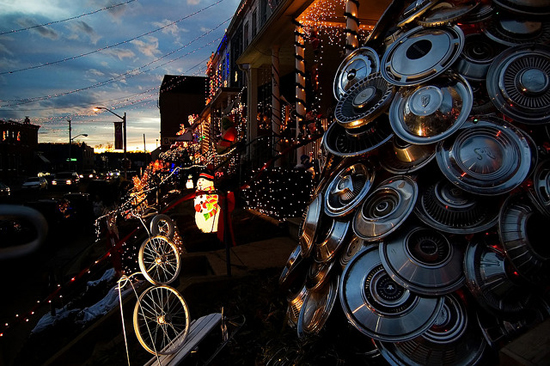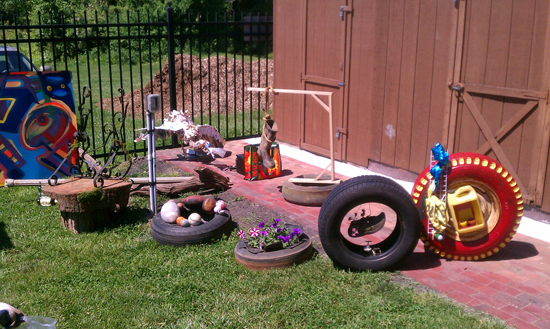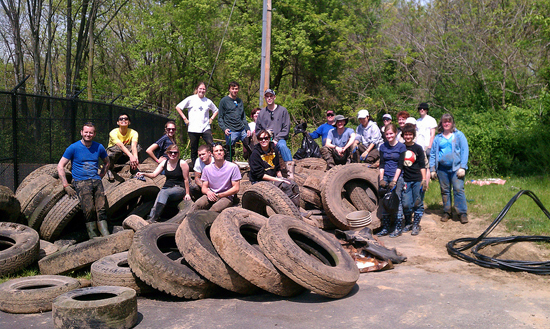Watershed Wednesday: Back River Restoration Committee (Essex, Md.)
One Baltimore organization has figured out what to do with trash in their local river: make art!
Merry Christmas in July! If you live in Baltimore, you may remember Hampden's Annual "Miracle on 34th Street" celebration, the few weeks before Christmas when houses in the eclectic Baltimore neighborhood dress up their front yards and porches with everything and anything that is light-up, singing, or just plain funky (think kitschy singing Mickey Mouse figurines and decorative Old Bay cans).

Image courtesy sneakerdog/Flickr
The event is becoming more than a local tradition, attracting thousands of visitors this holiday season and using a lot of electricity.
But one 34th street resident found a way to still "go green" despite high energy consumption; Jim Pollock’s decorations consistent of repurposed and recycled trash. As a fine arts major-turned-environmental writer, I remained fascinated with his hubcap Christmas tree long after the holidays had passed. Pollock makes art out of discarded materials, an idea that the East Baltimore environmental organization, Back River Restoration Committee (BRRC), promotes through their annual TrashArt Auction.
This year, Pollock, along with Towson University and MICA art students and professors, collected trash from Back River and created art that was auctioned off to benefit BRRC.
This year’s $7,000 funded summer stipends for BRRC’s Civic Works summer crew members. These are students who work over the summer to clean Back River; that means dragging tires up stream banks and picking up floating diapers in the summer heat.
“When you pick up all the trash, and another rain storm comes and it's all back again, you have to do something to handle it mentally,” explains Molly Williams, Project Manager for BRRC. “You start to get creative and start to think about all the things you can do with it.”

Image courtesy Save Back River/Flickr
Some of this year’s items include a metal duck hunter made by Pollack, traffic cone jewelry, and various interpretations of tire art. These beautiful items exemplified the old adage, “when life gives you lemons, make lemonade.” Back River may have a lot of trash, but they are making the best of it!
The event also attracted a new crowd to BRRC’s mission, says Molly. “It brought many people out who wouldn't necessarily be at a cleanup.”
Back River’s back story
Located southeast of Baltimore City, Back River is situated between a highly populated urban center and the Chesapeake Bay. That means much of the city’s trash floats into Back River.
"Since we have been working to clean up trash in the river, we have begun to move upstream into the neighborhoods to reduce litter and dumping through campaigns, incentives, and awareness,” says Molly.

Image courtesy Save Back River
While the local group cannot entirely control how much trash upstream residents throw into the river, they can collect it before it goes into the Chesapeake Bay! A “trash boom” is a device that sits across the river horizontally and collects debris from upstream. Volunteers then work to empty the boom as needed. In fact, this summer, BRCC is celebrating its one year anniversary of trash boom maintenance!
The largest “boom” in the “trash boom” is after a rain storm, when a high volume of water quickly enters Back River, carrying trash along with it. (The above photo was taken after a June 1 storm event.)
This video gives you a look at the trash from the water’s angle: http://www.savebackriver.org/?page_id=774
But trash isn’t the only problem; two Superfund sites along the river leak hazardous waste into Back River. The combination of Superfund pollution and incoming trash makes Back River one of the most impaired Chesapeake Bay tributaries.
Under these conditions, it is easy to see why Back River enthusiasts may get discouraged. But a growing, committed volunteer force continues to invent creative ways to keep their community’s river clean.
“We had over 250 volunteers at our last cleanup,” says Molly. “The community is very engaged.”
According to Molly, river residents have reported seeing more wildlife along the water since Back River began cleanup efforts.
“People who live on the water and have lived there forever say they have seen a dramatic increase in that amount of life, and a decrease in amount of trash,” says Molly. “We are getting really positive feedback from all the surrounding communities.”

Image courtesy Save Back River/Flickr
More from Back River Restoration Committee:
- Tree planting events (funded through Maryland Department of Natural Resources) engaged over 500 students in plantings this year. Storm drain markings and trash pickups are other ways teachers get their students outdoors.
- Waterfront households along Back River agreed to care for 15 oyster cages distributed by the Oyster Recovery Partnership in summer 2011.
- See what it’s like to clean Back River every day! Watch videos and read blog posts by BRCC’s summer crew members.
- Highway cleanups, Veggie-growing contests, and shrimp feasts! Check out what other events BRRC has in store this summer.
- For photos of last year’s TrashArt Auction, check out BRCC’s Flickr Page.

Comments
There are no comments.
Thank you!
Your comment has been received. Before it can be published, the comment will be reviewed by our team to ensure it adheres with our rules of engagement.
Back to recent stories